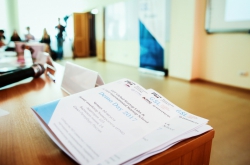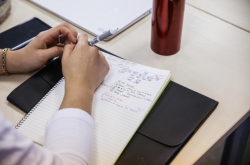Your background is in film and TV producing. How did you end up making a music-centered startup?
I first thought about digital input of sheet music back in school. I’ve been involved with music since I was a child. I took flute lessons, then I got into the acoustic guitar, learned to play the electric guitar and realized that I want to compose music. The idea of coming up with a specialized keyboard for notation writing first came to me in 2014: at that time, I had already studied music theory for three years with my teacher – and co-founder of d notation – Roman Ruditsa. Roman is a remarkable composer, music theory expert and pianist. For my studies, I had to do written harmonics tasks, which made me wonder if there’s a better way to do it than by hand; I realized that no one has yet to invent a truly comfortable notation writing medium. It was obvious to us that there is no truly great tool on the market; we have the QWERTY keyboard for regular text, and it’s easy enough that even little children can learn to use it. Notation writing needs a similar tool, something natural and accessible that can be used without lengthy training or having to read manuals. It should suit everyone, from first-timers to professional composers. We managed to do just that. Last summer, we applied for the eight-week MIT Global Startup Labs program and completed it successfully.
How did the project change while you were at MIT Global Startup Labs?
The most important thing we learned from our MIT tutors is to use a systematic approach when analyzing the market. The program’s curators have a very precise methodology for developing the projects’ market strategies. I found that information very valuable, as I had never learned about something like this before. Having received this new knowledge, I reconsidered the project’s development plan. One of the mentors also analyzed the app’s usability and user experience, making some detailed and valuable notes. At the same time, I took part in the Higher School of Economics’ competition Innovation in Education 2017; I won and got the chance to come to the US to present my project to a different audience and potential investors, as well as learn more about the American musical education system.

Why didn’t you take part in any acceleration programs or join a business incubator?
We had offers from Russian incubators, and, lately, American ones, but so far we haven’t taken up any of them; for now, it’s important for us to release our MVP (minimum viable product, which developers use to receive customer feedback, evaluate the product and make the necessary adjustments – Ed.) for the American market. This same MVP will also be tested on the Russian market, but our goals for the two markets are entirely different.
What are these goals?
In Russia, our main objective is to integrate the project into the educational system to help schoolchildren learn about musical notation. We have many renowned musicians supporting us in this endeavor. Tutors from many of the country’s regions have already assessed our app per the Ministry of Culture’s request, and many educational institutions – from regular schools to music conservatories – took part. Among them are the St. Petersburg State Conservatory, the Gnessin Russian Academy of Music and others. Some schools have already made pre-orders. We plan to work with all of the Russian educational institutions that teach music in any way; nevertheless, our main goal is to integrate the app into the mainstream educational system, and for that purpose we are working with state institutions.
In the United States, we’re working on two markets, B2B and B2C. This past October I visited the main higher education institutions of the East Coast. It appeared to me that the musical community was very interested in an application that could replace the regular, paper-based notation book. Of course, integration in the US will be much faster, but we’ll try to speed up the process in Russia, too. The thing is, the American market is ready for such a change – there are no legal or technical obstacles to overcome. They sign up for the application and just start working.

In Russia, how do you present your project to educational institutions – through the Ministry of Culture or by approaching them directly?
It’s different for each case. For example, the St. Petersburg Cultural Committee organized a presentation of our project for the city’s musical schools; the committee’s representatives accompanied me to present it at schools and collected feedback from the teachers. We’re currently looking for partners among educational companies both in Russia and the US to see if they might be interested in working together to promote our app in schools and universities.
What did you accomplish during your trip to the USA?
I met with professors from various universities – including MIT – and the tutors and deans of various musical schools. In the two weeks that I spent there, I met a great deal of specialists in the music industry who told me how the American system of musical education works. All that made it clear to me that we can successfully enter the American higher education market. Universities want to replace paper notebooks with smartphones and tablets and let their professors use digital technology to teach, and we’re fulfilling that need.

How much are the musical communities in USA and Russia open for this sort of innovation?
There are those who support our idea right now and those who are waiting for its full implementation. I went to the Society for Music Theory’s 40th Annual meeting – that is the main conference for music theory experts in the US, held in Arlington, VA. Each year, 740 theorists and tutors from all across America come to this event. Many specialists I’ve met there were excited about our project. In Russia, too, we got a lot of praise from schools and universities all over the country. Some tutors are actively supporting the project and its integration. The problem is less about support and more to do with how we have a very complicated system for selling paid subscriptions to educational institutions, which has to do with the procedures state educational institutions have to follow when paying for services. But there is another problem, perhaps one that’s even more critical: schools, even musical ones, lack technical equipment such as tablets. In Moscow there are maybe 15-20 schools where classrooms are equipped with the right equipment, and I know of only one such school in St. Petersburg. This makes the process that much more complicated, as I can’t just tell the teachers and students to use the application. For now, they test it using their own devices, but I’m working to solve this issue.
Tell us more about the app itself.
It’s currently in closed testing, with users from Russia and USA participating. When we created it, we didn’t base it on any existing apps, but we did analyze different notation software, one of which I’ve been using for more than 10 years now.

What other international markets did you consider before your trip to the USA?
We considered Europe, but realized that it’s better to work with a single, large foreign market that only uses one language. In order to enter the European market, we’d have to take into account the specifics of each country. Among our possible options were the German, UK and French markets, which are among the largest in Europe.
How expensive is this project? Did you receive any investments?
Over the years we’ve developed the project using our own funds. We also won a grant from the Foundation for Assistance to Small Innovative Enterprises (Bortnik Fund); we used that money to develop and test a prototype.
You’ve mentioned that many teachers are awaiting the app’s release. How do the students themselves react? Have you seen any feedback?
Overall, the testing of d notation’s prototype by school and university students was promising: we get great feedback and, most importantly, all of the testers were quick to get the hang of our app. Many of them liked it so much that they’re willing to participate in its further development.
We will be releasing an MVP in the near future, which will be available to everyone.





